Best Borehole Drilling Company
Best borehole drilling company
As the best borehole drilling company in Kenya, we not only drill wells but thoroughly guide farmers on what is needed to procure borehole drilling services from Grekkon Limited. When the borehole is complete, we provide a borehole water pump that evacuates water to a storage unit. Our borehole pumps are submersible solar or electric types. In this piece, we provide a breakdown of the average cost of drilling a borehole in Kenya depending on the drilling method adopted
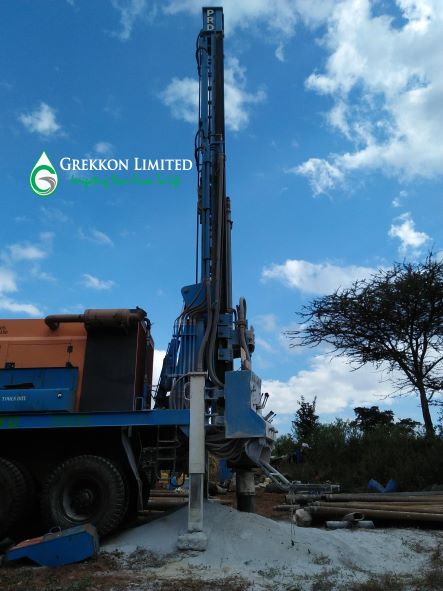
A Grekkon Limited’s borehole drilling rig in Yatta, Machakos county
Requirements for drilling a borehole in Kenya
1. Hydro-geological survey
- Conduction of a hydro-geological survey to establish the water potential of an area. It provides; the point of drilling, depth, rock structure and the approximate amount of water present beneath. The latter is determined by assessing the yield of neighboring boreholes. This is a day’s job depending on the size of the area being surveyed. Geo-physical instruments are used to carry out this. The methods of survey are; resistivity method, vertical electrical sounding (VES), and horizontal electrical profiling (HEP)
- Review of the hydro-geological survey report
- The cost of a hydro-geological survey in Kenya is Kes 115,000. This cost covers payments for all permits and licenses
The client must provide these documents for Water Resource Management Authority (WARMA) permit processing.
- The land title deed proving ownership or the sale agreement if the land transfer isn’t complete from the previous owner
- His/her identification card for individuals or the company registration certificate and CR12 for corporates
- The personal identification number (PIN) certificate
2. Licenses and permits
- Client submission of licenses and permits from; WARMA, National environmental management authority (NEMA), and the county government (if the county government must approve)
3. Site visit
- Physical site visit for logistics assessment
4. Payment
- Generation of a detailed quote
- Down-payment of 75% of the total amount
Our borehole drilling price in Kenya varies with the drilling method, which is determined by the rock structure. Below is an indicative price tabulation
Borehole Drilling Price In Kenya
| Drilling Method | What it entails | Price in KES Per Meter |
| 1. Air drilling | Drilling on stable ground that has a proper rock formation beneath | KES 6,700 |
| 2. Mud drilling | Drilling on loose ground that has no or minimal rock beneath | KES 13,050 |
What To look Out For When Drilling A Borehole
i. Proximity from other boreholes
ii. Availability of electric power
iii. The slope of the land
Cost of Drilling A Borehole in Kenya
Details| Process | Cost Per Meter- Air drilling method | Cost Per Meter- Mud drilling method | |
| 1 | Mobilisation | KES 420 | KES 420 |
| 2 | Drilling | KES 3,220 | KES 9,470 |
| 3 | Casing | KES 2,269 | KES 2,569 |
| 4 | Graveling | KES 280 | KES 180 |
| 5 | Well development | KES 70 | KES 70 |
| 6 | Test pumping | KES 420 | KES 320 |
| 7 | Water chemical analysis | KES 21 | KES 21 |
| Total | KES 6,700 | KES 13,050 |
Note that the mobilisation cost varies with the location. The cost of drilling a borehole in Nakuru will be different from the cost of drilling a borehole in Wajir
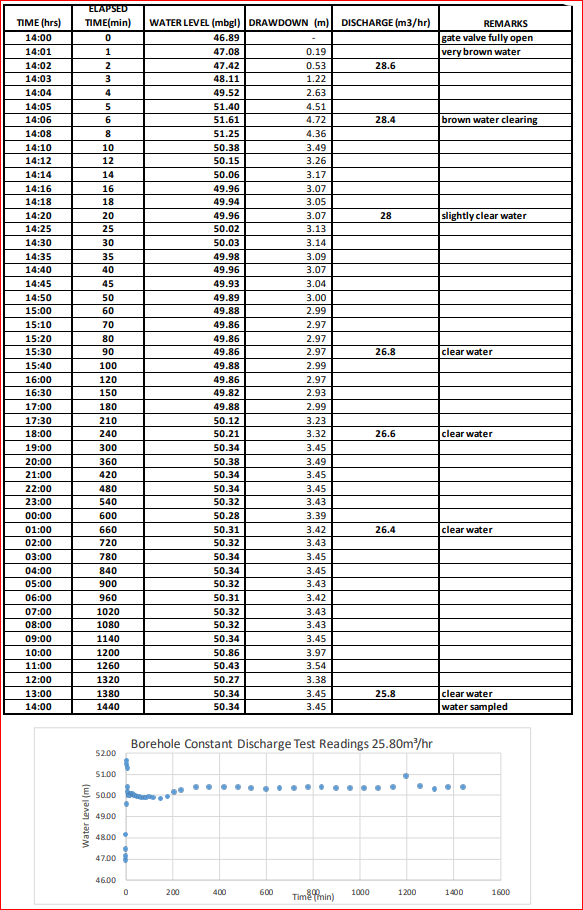
A sample test pumping report
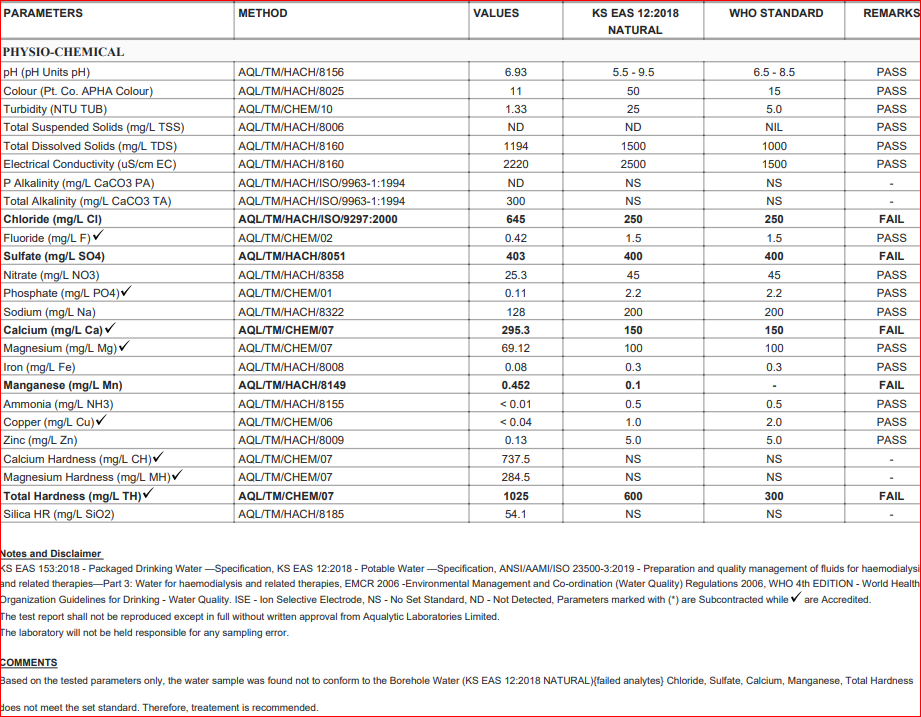
A sample water analysis report

Borehole drilling in Mogotio area, Baringo county by Grekkon Limited for community use
How to drill a borehole in Kenya; What the drilling cost entails
Mobilisation
This is the transfer to the well site of the rig, equipment, and labor. We cost mobilisation by distance. A borehole project 500kms away from our office will pay more for mobilisation than one that is 50kms away. Mobilisation costs allow for bush clearing and site preparation costs. This is to ready the borehole drilling site for the drilling rig and all other heavy equipment
Borehole drilling
This is the actual process of sinking a well in the ground in order to obtain water. The depth of sinking depends on the reading of the hydro-geological survey report. This report states the depth, amount of water expected, and the geological structure of the soil and rock underneath. The common size of the borehole well is 8 inches in diameter, but the surface section is 10 inches. Some wells are larger, going up to 14 inches in diameter
Casing
We line the walls of the borehole with mild steel or polyvinyl chloride (uPVC) casings. This is to keep the wall from collapsing throughout the lifetime of the borehole. We install 4mm – 4.5mm thick steel casings where the well has boulders, and where mud drilling is conducted. uPVC casings are installed in wells that lack boulders or that are rich in sand, and the water is highly saline. High salinity causes intense rusting on steel casings over time, hence the preference for uPVC casings in such wells
There are 2 types of casings
3.1. Continuous casings. They line the sections where the aquifer(s) is absent. They serve as water storage units because this is where the water is held. Surface casing are set from the mouth of the well downwards to the point where the walls are stronger. It could be as short as 3M, or as deep as 30M. Surface casings are 8″ in diameter
3.2. Slotted casings. They line the aquifer sections to allow water into the well. The slots are 1mm to 2mm in size
Our installation ratio of continuous and slotted casings is 70:30. This ensures maximum percolation of the water from the aquifer into the borehole
4. Graveling
It is the application of gravel sand between the borehole walls and the mild steel casings. Gravel filters soil and other impurities and keeps the casings firmly in position. Our gravel size is 2mm to 4mm, and well rounded
5. Flushing and capping
The well is cleaned of all chippings, a process referred to as flushing which is done after casing and also after graveling. Where casing is not carried out, flushing is done too. It is the process of pushing water within the well under intense pressure, then releasing it as a jet from the mouth of the well. Flushing allows optimal water flow from the aquifer to the well, and it precedes test pumping. In a high yielding borehole, the water within the well is used to clean it up. Where the well is low in yield, additional water is sourced for externally and added into the well.

Grekkon Limited’s team flushes a low yield in Lukenya area, Machakos county. Notice the use of additional water from a water bowser on the left
After flushing, the well is sealed at the top with a cap to prevent dirt and other material from getting in
6. Test pumping
We draw out borehole water for 24 hours. This shows the yield of the well, recharge rate and water level. It is with this report that we determine the right solar or electric submersible water pump. Before the test pumping process, we determine the most suitable test pumping water pump and the right pipe diameter to use based on the estimated volume of water in the well. Our test pumping pipe diameter sizes are installed as;
| Estimated Borehole Yield | Test Pumping Pipe Diameter |
| 0.5 – 10 cubic litres per hour | 1″ |
| 11 – 25 cubic litres per hour | 1-1/2″ |
| > 25 cubic litres per hour | 2″ |
Having the right test pumping pump and pipe diameter size is key in achieving the right yield of the well
7. Water chemical analysis
Laboratory analysis of the chemical composition of the borehole water

A complete borehole design showing all parts
Borehole Drilling Questions
FAQs to Borehole Drilling Services in Kenya
How much is drilling a borehole in Kenya?
As the best borehole drilling company in Kenya, we tailor our price according to the hydro-geological survey result finding
How many meters is a borehole?
From 50M and below, a well qualifies as a borehole
How deep is good borehole?
A good depth one where the most productive aquifers are reached, and with good water quality
What is the average depth of a borehole in Kenya?
None. This is by location only because the variances are large.
How do you know where to drill a borehole?
Through a hydro-geological survey by an independent hydro-geologist. It determines; water availability at which point, how much water, and at what depth
How many days does it take to drill a borehole?
It depends on the depth and the rock formation
How long does a borehole last?
It lasts in as much as the water table or aquifer remains
What is a good borehole yield?
It depends on water usage. For domestic use, a yield of 2 cubic meters per day is sufficient for a homestead. For farming, a higher yield is better
Can a borehole be drilled anywhere?
No. Only where there is a water aquifer. This is why a hydro-geological survey is conducted to show exactly where the water source is
Can borehole water run out?
Yes it does when the water aquifer dries up
Do I need permission to drill a borehole?
Yes, permission must be sought. 3 certificates and permits are needed in order of priority listed below
- Water Resource Management Authority (WARMA) certificate
- National Environmental Management Authority (NEMA)
- County government permit (in counties that demand this)
As the best borehole drilling company, Grekkon Limited’s agronomy team will design a crop irrigation system for all borehole clients without charge. We provide a detailed crop growing program with on the ground agronomy support for the first season of the crop


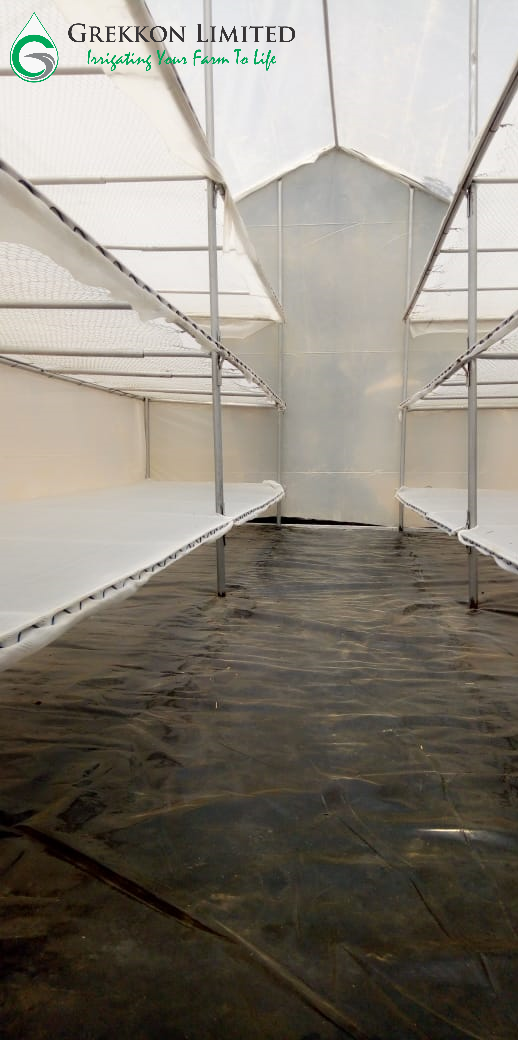

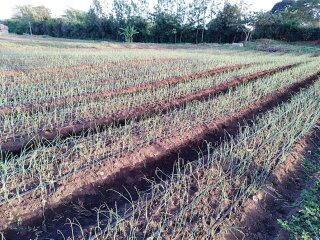
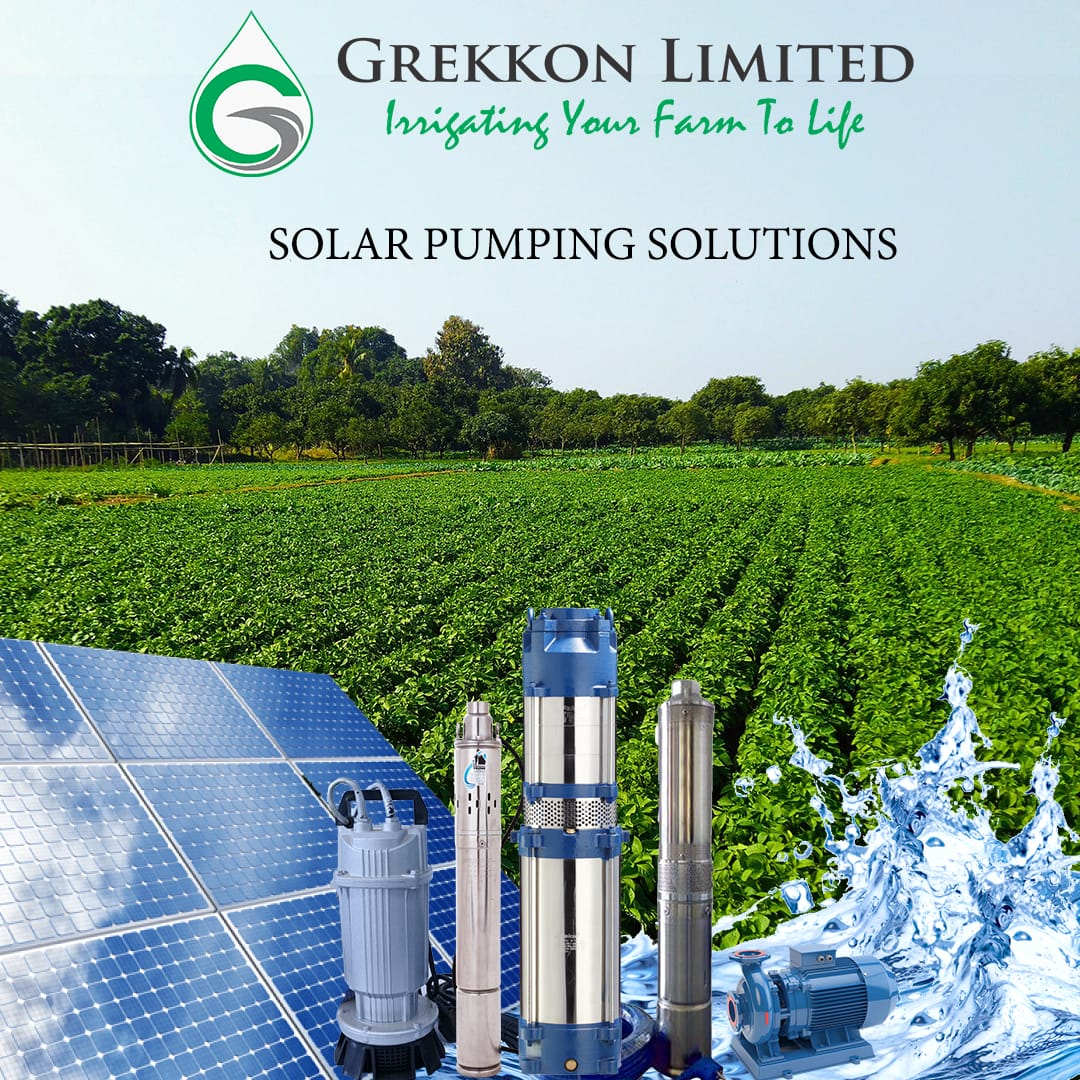

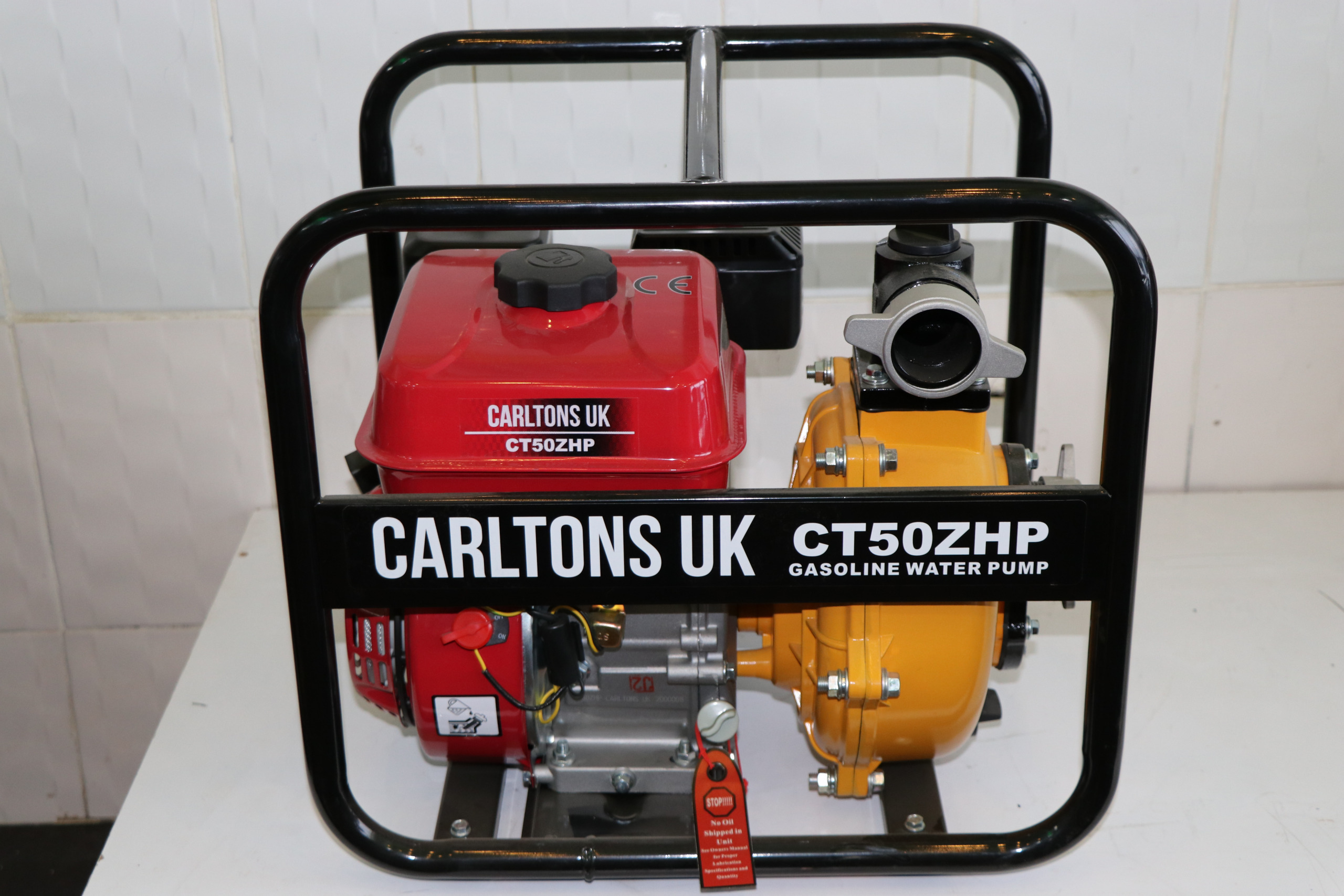
I would like to know possibilities of having a borehole at Riat Kisumu
Please get in touch with me.
Beatrice
Good evening Obara,
Please inbox us your phone contacts on info@grekkon.co.ke
Best regards,
Customer Service
Hey,
Have done borehole,pumb testing , tower done and tank of 10,0000ltrs the rest not, i need solar. Please advice.
Thank you in advance
Patrick 0721751761 (kibwezi in Makueni county)
Good morning Patrick,
For a detailed solar submersible water pump quote, please share with us your test oumping report on info@grekkon.co.ke
Best regards,
Customer Service
I have a borehole, 50 feet deep. How much would it cost to install a water pump that pumps water to my tank? I am talking about a reliable water pump that will last for years.
Good morning Gideon,
For your borehole solar submersible water pump quote, please share with us your test pumping report on info@grekkon.co.ke
If you haven’t done test pumping,we’ll undertake it to determine your most suitable submersible water pump specs
Best regards,
Customer Service
Saw one your projects in Muthuani Joska. Your electrical engineer is doing an awesome job. That young man is a master in pumping section especially handling questions gave me a better understanding. Planning starting a similar project soon.
Good afternoon Justus,
Many thanks for the kind compliment. The same will be shared with the said technician. We look forward to being of good service to you too
Best regards,
Customer Service
Iam organizing my self to drill water soon.so I will get in touch
Good morning Solomon,
Once you’re ready, so are we.
Best regards,
Customer Service
Kindly send me a full quotation for drilling a borehole in kericho County. Soon sigowet
Good morning Hesbon,
For a detailed quote, please share with us your hydrogeological survey report on: info@grekkon.co.ke
Best regards,
Customer Service
A quote for drilling borehole in Lower Nyakach in Nyakach Constituency in Kisumu County.
Good morning Odero,
For your borehole drilling cost quotation, a hydrogeological survey must be conducted, and relavant permits provided
Please email us your contact number on kisumu@grekkon.co.ke for us to reach you
Best regards,
Customer Service
I need to drill one at kithini near machakos town
How much will it cost to drill one at kithini near machakos town
Good afternoon Daniel,
For your full borehole drilling quote, please share with us your hydrogeological survey report
Best regards,
Customer Service
Hello I would like to be drilled a borehole at our home in Kabondo Homabay County.
How can we get in touch.
Regards
Vincent 0751119696
Good morning Vincent,
This is noted. Our Kisumu office will reach you shortly
Best regards,
Customer Service
I wanted to find out the cost of drilling water in Kinangop, a place called flyover
Good morning Lucy,
For your borehole drilling cost, please share with us your hydrogeological survey report
Best regards,
Customer Service